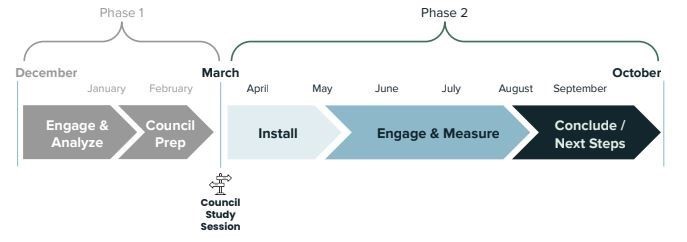Heads Up March 3, 2023
City staff provided City Council with an update today on the Downtown Streets as Public Spaces project. In the interest of transparency, we are posting it here as well.
Dear council members:
Here’s some need-to-know information for the week:
Downtown Streets as Public Space project wraps up first phase of engagement and analysis; recommendations to be released in council memo March 10
The Downtown Streets as Public Space (DSaPS) project, which launched in December 2022, is wrapping up its first phase of community engagement and technical analysis. This heads up is to give council and the community a glimpse of the team’s activities and initial learnings in advance of a detailed memo next week.
The project builds upon the significant community interest that accompanied the temporary closure, and subsequent reopening, of a portion of West Pearl to vehicles during the COVID-19 pandemic. The goals are to:
- Collectively reflect, learn from, and build on a variety of experiences
- Ensure that recommendations for downtown streets for public space reflect diverse community voices, as well as feasibility and technical analyses
- Develop a series of recommendations to implement in spring/summer 2023 that will test ideas for reimagining streets in downtown locations
- Use the project outcomes to inform upcoming planning efforts and future policy discussions about streets for public spaces in the city.
Council Members Tara Winer and Matt Benjamin were appointed to a council process subcommittee and have been helping to guide the process portions of the project. The city also hired the team of Fox Tuttle Transportation Group, Gehl People, and Leadline to provide additional project management capacity and technical expertise in urban design and transportation analysis. This team has been busy since launch, with two parallel tracks.
Engagement
The first was a new round of engagement, which sought to address potential gaps in participation and points of view in the many emails City Council received on this topic last fall. Community members were invited to participate in the following ways:
- An online questionnaire and interactive map on Be Heard Boulder from Jan. 12 to Jan. 31
- A series of in-person events, with quick-hit opportunities to provide feedback
- Interviews with a variety of stakeholder, partners including business groups
- Consultation with members of the city’s Community Connectors program, which seeks to lift the perspectives and voices of populations that have been historically excluded from local government, city planning and decision-making
While the engagement occurred over a relatively short period of time, the level of participation was high, with more than 1,850 people weighing in through one or more of the options. A detailed summary of the engagement, including data, will be released on March 10, as part of a packet for the March 23 study session memo. The following are some of the key takeaways from the engagement conducted to date:
· Desired experiences: Community members enjoy downtown for a variety of reasons, primarily to shop, dine, socialize, people watch and enjoy nightlife.
· What's missing from current experiences: Participants identified concerns about safety and public health; affordability (both for business owners and consumers); and challenges related to mobility, access and/or parking. The city also heard clearly that some residents do not feel welcome downtown, and others expressed a desire to round out what are perceived as activities designed to attract tourists with more organic and community-centered options.
· Travel preferences: People use a variety of ways to get downtown, including primarily by bike, foot, or personal vehicle. Inclement weather shifts preferences heavily toward use of a personal vehicle.
· Abundance of activators: There are many ideas to activate downtown. Activators – individuals or groups who can create programming and events within re-purposed street spaces -- will need permitting and, sometimes, financial support from the city.
· Equity and inclusion: There was a consistent emphasis through all engagement efforts that the city should seek to increase inclusivity through the type of activations, as well as increase collaboration, accessibility and affordability, to create a sense of belonging for all.
· West Pearl listening and learning: While this project strives to consider a wider range of downtown locations for re-purposing streets, it is clear that much of the feedback stems from individuals’ experiences in the context of the West Pearl closure. Some community members expressed continued frustration that the street was reopened to vehicular traffic. At the same time, West Pearl business owners who were directly impacted by changes to street use during the pandemic shared that they did not feel heard or represented in previous community conversations about this topic. More dialogue and a collaborative approach to planning will be necessary to build greater trust and support community alignment.
· Eye on long-term impacts. The Boulder community wants to see the city moving towards more resilient, sustainable, and people and community-centered policies in the long-term recommendations.
Technical Assessment
While soliciting more feedback from the community, the city also tapped the expertise of consultants in urbanism and transportation. This team assessed a variety of street segments downtown and shared best practices for creating people-centered public spaces. The following are some of the key findings, which will guide the upcoming recommendations:
· The scale of transformation needs to match the level of activation. We must ensure there is a purpose to any street closure because public spaces need the presence of people in order to feel vibrant, inviting and safe.
· Boulder businesses are key partners in enhancing life downtown. Many people enjoy downtown because of the experiences that businesses provide. As the city reimagines its streets together with the community, it will be important to bring all stakeholders, including businesses, along in the process. In review of similar street transformations across the country, a key takeaway is that all successful transformations had the active and excited interest from both the business community and general public.
· The city should build on already strong activation. We may have more opportunity for exciting experiences if we leverage and amplify existing activations while also trying out some new ideas.
· The city can transform streets without requiring a full 24/7 closure to vehicles. A variety of tactics can be used to create people-centric places. Full street closures are not the only tool to achieve a fun, enjoyable and inclusive experience. Closing streets to vehicular traffic permanently requires additional technical, operational and legal evaluation. If this becomes a community goal, it is likely to take time. Meanwhile, the warmer weather in the months ahead provides an opportunity to test new ideas through a series of temporary, or pop-up, activities and street treatments to inform future plans for, and investment in, the public realm.
What happens next?
What started as an emergency economic recovery strategy has become an experiment in reimagining the role of streets in Boulder. Here’s what we expect over the remainder of this project:
· The project team is developing a set of recommendations to enhance enjoyment of community streets. These recommendations will be available on March 10, as part of the materials released in advance of City Council’s study session on March 23.
· Based on council’s input, staff and community partners will implement the recommendations for spring and summer 2023.
· Engagement with the community and stakeholders will continue during the experimentation phase to seek input on peoples’ experiences. The learnings will be used to craft long-term recommendations for more people-centered places that balance different needs and help to achieve a more connected and sustainable future.
Here is an at-a-glance of the process and where we currently are:

For more information about this project, please contact Senior Project Manager Noreen Walsh at walshn@bouldercolorado.gov. Anyone interested in pursuing programming opportunities in the downtown street spaces this year may contact the city’s Events Senior Program Manager Justin Greenstein at: specialevents@bouldercolorado.gov.
Neighborhood Connection Grants back for 2023
Neighborhood Services has re-launched the Neighborhood Connection Grants for 2023. The grant program is designed to increase opportunities for neighbors to get to know each other in fun, relaxing and positive ways. The very popular Spark Grant and Block Party Grant will return along with other new grants.
This year’s program focuses on healing and resilience as themes. There are five grant programs in total to choose from. They range from a couple hundred dollars up to $3000. Deadlines for applications are on a rolling basis and depend on the grant. Applications are available in English and Spanish.

More information about the grant program can be found here.
If you have questions, please reach out to Neighborhood Liaison Edgar Chavarria at chavarriae@bouldercolorado.gov.
Dashboard now available to track 2022-2023 Council Priorities
The city recently published a Smartsheet dashboard to provide information about progress on 2022-2023 priority projects of the Boulder City Council. Updates are made on a monthly basis, and information like timelines and milestones are subject to change as the work develops.
Find the dashboard at this link
If you have questions, please contact Assistant to the City Council Taylor Reimann at reimannt@bouldercolorado.gov.
Regards,
Nuria
